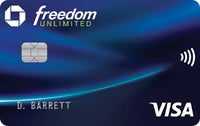Best business balance transfer cards

The Bankrate promise
At Bankrate we strive to help you make smarter financial decisions. While we adhere to strict , this post may contain references to products from our partners. Here's an explanation for . The content on this page is accurate as of the posting date; however, some of the offers mentioned may have expired. Terms apply to the offers listed on this page. Any opinions, analyses, reviews or recommendations expressed in this article are those of the author’s alone, and have not been reviewed, approved or otherwise endorsed by any card issuer.
Many businesses, even those that are profitable and well-run, might occasionally need to carry debt. Balance transfer credit cards can help you consolidate high-interest debt and work on paying it off over time at a lower or 0 percent APR. You’ll also find 0 percent APR offers for new purchases. However, balance transfer offers on business credit cards are much more rare.
A balance transfer card works like a regular credit card, with the main feature being an interest-free term for paying off transferred balances. After opening an account, you’ll have a window of time to transfer any balances, and you’ll almost always pay a balance transfer fee. Even if the card does offer rewards, balance transfers don’t typically count towards earnings. Your incentive is the interest you’ll save over the intro offer period. These cards can also help build business credit and provide perks like business tools and consumer protections.
If you’re looking for a business credit card that makes it easier to consolidate and pay off credit card debt, here are some of the best business balance transfer cards.
Comparing the best business balance transfer credit cards
| Card | Best for | Balance Transfer Intro APR | Time to transfer | Regular APR variable | Bankrate Score |
|---|---|---|---|---|---|
| U.S. Bank Triple Cash Rewards Visa® Business Card | Earning cash back | 0% for first 15 billing cycles | 30 days | 19.24%-28.24% | N/A |
| U.S. Bank Business Platinum Card | Longest introductory term | 0% Intro APR on purchases and balance transfers for 18 billing cycles | 30 days | 17.24%-26.24%
17.24% - 26.24% (Variable) |
2.1 |
| PNC Visa® Business Credit Card | Longest time for transferring a balance | 0% for first 13 billing cycles | 90 days | 15.24%-25.24% | N/A |
| Chase Freedom Unlimited® | Sole proprietors | 0% Intro APR on Balance Transfers for 15 months | 60 days | 20.49%-29.24%
20.49% - 29.24% Variable |
5.0 |
Top business balance transfer credit cards
U.S. Bank Triple Cash Rewards Visa Business Card

U.S. Bank Business Platinum Card
PNC Visa® Business Credit Card

Chase Freedom Unlimited®
How to choose a business balance transfer credit card
Assess your business needs when considering business balance transfer cards. You’ll want to find the right tools to consolidate your debt with the most favorable terms based on your creditworthiness.
Prioritize consolidating high-interest debt
Examine how much high-interest debt you want to consolidate. You’ll want to make credit card debt payoff your top priority, so look for the longest 0 percent APR period available for a balance transfer, and try to pay your balance by the end of your intro APR term. You may not receive ongoing rewards or a welcome bonus, but the ability to knock out debt without additional interest should outweigh that. Also, consider the variable APR after your introductory term expires if you won’t be able to pay the entire balance fully.
Find terms that work for you
No matter how much debt you have to pay down, pay attention to the balance transfer terms, including balance transfer fees, the window to transfer balances and the term of repayment.
If the balance transfer fee is too high, it might not justify the savings on interest. For help in crunching the numbers, use Bankrate’s credit card balance transfer calculator when comparing options.
Once you know how much debt you want to transfer, consider the length of the introductory offer to determine how much you’ll need to pay monthly to pay it off without additional interest. For example, if you transfer $10,000 of debt for a 15-month intro period and a 3 percent balance transfer fee, you’ll need to pay $687 a month to pay the balance in full before interest charges apply.
Check your eligibility
Find the minimum credit score needed to qualify for a card, and check your credit score to see where you stand. While a business credit card may not impact your personal credit, issuers may consider your personal credit score when you apply.
Maximizing business balance transfer credit cards
Find the ideal terms for transferring balances that work for your business and utilize what they offer to the fullest extent. Only a few cards offer intro APR rates that include balance transfers, so consider the following as you decide.
Consider an intro purchase APR instead
If you have large upcoming purchases for your business in addition to your existing debt, you might look for a credit card offering an intro APR on purchases instead of a balance transfer offer. Intro purchase APR offers are more widely available, giving you more business cards to choose from while earning rewards or a sign-up bonus to assist with paying down debt.
You may choose to pay down your debt by making all your upcoming purchases on your intro purchase APR while paying down more of your existing debt. You won’t accrue interest charges on your purchases and can make smaller payments during the intro purchase term while paying off more of your high-interest debt.
However, be careful not to overspend. If you don’t pay the balance by the end of the intro offer term, you’ll be on the hook for interest charges. If done wisely, you can pay less overall interest if you strike the right balance of payments and purchases.
Pay your balance in full
Make sure you pay your balance in full by the end of the balance transfer term to avoid expensive penalty fees or interest charges. If your card has a high APR, then you might be adding to your debt significantly.
Build your credit
If your credit is less-than-ideal or if you are just starting out, consider how these cards could help you build your credit and improve your credit score. With responsible card use, you can gain access to better card opportunities.
Frequently asked questions
-
Any type of business structure is eligible to open a business credit card. This includes corporations, limited liability companies, partnerships and sole proprietorships.
-
Business credit card activity isn’t typically reported on your personal credit report, but exceptions exist. Issuers might report your credit card to consumer credit bureaus if your account becomes delinquent.
-
Using your business credit card for personal expenses technically isn’t illegal. However, it could violate the terms and conditions of your card agreement, which can come with severe consequences, such as account closure or forfeiting rewards. It also makes it more challenging to track your business expenses and can have tax implications. It’s good practice not to make a habit of putting personal expenses on a business card.
What’s next?
Get the resources and products you need to grow your business.
The bottom line
A business balance transfer credit card offer is worth considering for consolidating debt. The best balance transfer options offer lengthy introductory 0 percent APR rates, although you’ll usually pay a balance transfer fee.
As you consider your options, remember that even the best small-business credit cards won’t help unless you pay off as much as possible during your card’s introductory period. Evaluate your budget and have a plan to pay down debt before you transfer balances to a new card.
Related Articles





